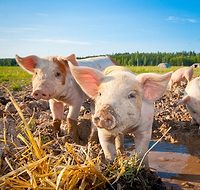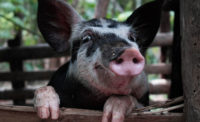African Swine Fever Will Accelerate the Transformation of China’s Pork Industry

China’s battle to control African swine fever (ASF) highlights the need for continued modernization of the world’s largest pork industry and is accelerating the ongoing transformation. China produces and consumes nearly 700 million hogs per year, about 50 percent of the world’s total.
Since August 2018, more than 100 cases of ASF have been discovered across 24 provinces in China. It is a highly contagious porcine virus with no vaccine or cure, and usually leads to a pig’s death within a week. According to the World Organization for Animal Health, ASF poses no risk to human health.
China has quickly taken measures to control the disease, including culling more than 900,000 pigs, restricting the transportation of live pigs and pig products, closing some live hog markets, and banning the use of kitchen waste to feed pigs.
Eradication of ASF could take years or even decades, and will require comprehensive, long-term measures. The urgency of containing the disease will accelerate the pork industry’s ongoing shift from small farms and manual slaughterhouses to integrated supply chains with industrial farms, large-scale processing, and cold chain distribution.
The sector’s modernisation will require a continuing influx of technology, expertise, management experience, and capital.
Restrictions on Shipping Live Pigs
Before August 2018, live hogs were often shipped long distances to slaughterhouses in China, due to differences between prices in various locations. Live pig shipping can spread the ASF virus. To combat ASF, the government intends to accelerate transformation of China’s supply chains from “shipping hogs” to “shipping meat.”
In recent years, about 15 percent of China’s hogs were shipped across provincial borders. ASF control measures caused inter-provincial shipments to drop from over 2 million pigs/week in July 2018 to about 4,000 pigs/week during the first 2 weeks of January 2019, according to data from China’s Ministry of Agriculture and Rural Affairs (MARA).
At the end of 2018, MARA published the Notice on Regulating Live Pigs and Pig Product Transportation Activities. It stated that live pig shipment is suspended from counties and provinces affected by ASF. The Notice included exceptions, however, for interprovincial shipping of breeding sows and commercial piglets from farms that meet strict biosecurity requirements, including mandatory ASF testing procedures.
By the third week of January, interprovincial shipments had rebounded to nearly 580,000 live pigs/week.
The Notice also allows for some shipping of live hogs from counties affected by ASF, but only from farms with modern biosecurity management systems and full-time veterinarians. Those shipments must use pre-approved routes and vehicles must meet detailed government requirements, including location tracking devices.
Consolidation of a Fragmented Farming Sector
Significantly, the new restrictions on live hog shipping make it increasingly difficult for small farms to sell their livestock.
In 2016, China had nearly 43 million farms that raised hogs, of which 40 million produced fewer than 50 hogs per year. About half of China’s hogs come from farms that produce fewer than 500 per year. In contrast, the U.S. has only 56,000 hog farms, with 90 percent of hogs raised on farms that produce more than 5,000 per year.
China’s largest hog farms use commercial feed and have modern biosecurity management. But tens of millions of household farms have low levels of biosecurity and are more likely to feed kitchen waste—a common vector for ASF transmission—to their pigs.
Household farms were already in rapid decline, driven by urbanization and China’s increasingly strict food safety, environmental, and biosecurity regulations. The number of farms producing fewer than 50 hogs per year fell from 80 million in 2007 to about 40 million in 2016.
At the same time, China’s leading feed, livestock, and meat processing companies have been building large industrial hog farms. The number of farms producing more than 50,000 hogs per year increased from 12 in 1999 to over 300 in 2016.
Government measures to control ASF and further improve biosecurity will accelerate China’s shift from household farms to large modern farms.
Consolidation of Processing
China’s hog processing is highly fragmented with a large number of small abattoirs. China has about 11,000 designated hog slaughterhouses, the majority of which are manual operations.
According to the State Council’s Rules for Slaughterhouse Management, hogs can only be slaughtered in “designated” slaughterhouses, that is, slaughterhouses that are licenced according to national food safety, quality, biosecurity, and environmental standards. The only exceptions are slaughter for self-consumption or locally supervised slaughterhouses in remote locations.
Of the nearly 700 million hogs produced in China in 2016, only 45 percent were processed in designated slaughterhouses. In contrast, the U.S. has 636 federally inspected hog slaughterhouses; and these processed over 99 percent of the US output of 121 million hogs.
In 2016, China had about 2,900 “scale” slaughterhouses, that is, those with capacity of more than 20,000 hogs per year. Scale slaughterhouses processed about 30 percent of China’s total hog production. In contrast, the 13 largest U.S. slaughterhouses each have an annual capacity exceeding 4 million hogs, and together processed 59 percent of US hog production.
China’s designated slaughterhouses suffer from low utilisation, but the sector is consolidating. Between 2007 and 2016, the number of designated slaughterhouses fell by nearly 50 percent, while the number of scale slaughterhouses grew by about 45 percent.
New government biosecurity measures favor large slaughterhouses. For example, MARA’s Notice imposes strict ASF-related restrictions, but includes exceptions for slaughterhouses that process more than 150,000 hogs per year.
The urgency of ASF control measures is accelerating the shift towards large-scale industrial slaughterhouses.
Building the Cold Chain
Approximately 80 percent of retail meat sales in China are fresh meat, compared to about 20 percent in the U.S. Fresh meat has a shelf life of 1–2 days, while chilled fresh meat has a shelf life of about 1 week. Because China’s cold chain capacity is limited, live hogs must be shipped to slaughterhouses located near the final retail consumers.
China’s per capita cold storage capacity is about half that of Western Europe and about one-third that of the U.S. As recently as 2015, only 34 percent of China’s meat products were delivered via the cold chain, compared to more than 95 percent in Europe and the U.S.
Nevertheless, China’s cold chain capabilities are growing quickly. Refrigerated warehouse capacity and refrigerated truck shipping have doubled since 2012. The percentage of meat products distributed via cold chain nearly tripled between 2009 and 2015.
The transformation from “shipping hogs” to “shipping meat” will accelerate the expansion of cold chain capacity to distribute pork products from large-scale processing facilities.
Fast Forward
In the short term, restrictions on live markets and transportation will make it more difficult for small farms to sell their hogs, and result in many leaving the industry. Small or unauthorized slaughterhouses will face similar difficulties in purchasing hogs and selling their products.
China’s leading “dragon head” companies have the resources to survive today’s difficult market and will accelerate plans to increase their market share of hog production and processing. Their large-scale industrial operations will be increasingly vertically integrated and will implement modern biosecurity, food safety, and environmental product practices. Growing cold chain and deep processing capacity will increase shelf life and distribution reach.
These changes were already envisioned by China’s National Swine Production Development Plan (2016–2020). The urgency of ASF control measures will accelerate these developments and create new opportunities for those companies that have relevant technology, expertise, and management experience.
Transforming half of the world’s pork production will require massive resources, but there is no doubt that it will rapidly move forward. Ensuring safe and adequate supply of pork for consumers in the world’s largest market is one of China’s top priorities.
Brian Marterer is a senior manager in PwC China’s Food Supply and Integrity Services team.
Looking for a reprint of this article?
From high-res PDFs to custom plaques, order your copy today!








